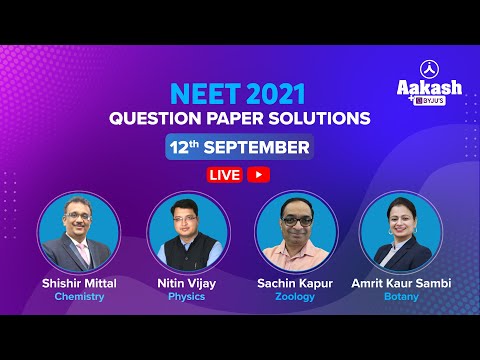NEET 2022 took place on 17th July 2022. While time and again the importance of practising from question papers has not been stressed enough, students often underestimate the impact, negative marking in NEET can have on their final score, knocking down their year-round preparations.
Download the Complete Guide to NEET UG Prep
Download Now
| Also see: NEET Key Answer 2022 |
Download NEET 2021 Question Paper
Most of the students have doubts regarding the marking scheme for NEET 2023 and has often come up with the question -“Is there negative marking in NEET”. In any competitive exam specifically, negative marking can be a big hurdle wherein candidates hesitate to answer, though they would have a slight idea. But one must understand that even slight guesswork would cost them a few thousand ranks.
A poll carried out on the answering pattern with negative marking conditions states that more than 60% candidates would prefer to leave questions, around 30% may or may not attend the question, while less than 10% of candidates would prefer to answer all the questions leaving no question unattended.
Also see: NEET Questions
Tips to avoid negative marking in NEET 2023
While the internet is flooded with hundreds of tips to overcome and tackle questions that may lead to NEET negative marking, we bring you the best of the tips helping you deal with the fear of attempting questions also to gauge questions that might lead to NEET minus marking and hence the course of action to be adopted for such questions.
As per the statistics of the survey carried out, there are three categories which will be covered in detail below:
1. The candidate leaves questions unanswered
This is one of the most common actions, often as a consequence of negative marking phobia. While this can be executed for 3-4 questions where you absolutely have no idea about the question, the same can’t be done for say 15-20 questions. It would have a huge impact on your overall score. As the candidate has not attempted questions, chances of a good score greatly reduce in this no-risk zone.
Is this a good approach?
As one does not attempt many questions here it reduces the chances of securing a good rank hence definitely not a good approach.
What can be done?
There is no substitute for a foolproof preparation. Doubts arise when you are not sure or haven’t read the concept, hence avoid being at that place. Cover all the concepts thoroughly. Still, if you come across such questions which you have no clue about, think of the nearest or closest answer, even now, if you do not manage to come to a conclusion, then move to the next question. But remember to strictly restrict this count to 1 or 2 to increase the chances of getting a better score.
Read also: NEET Notes
2. The candidate answers all the questions
The fear of missing out actually propels students to mark all questions without reflecting back on the consequences it could have on the final scores. Here, the candidate is not concerned with losing out on marks but just wants all circles to be darkened clearly.
Is this a good approach?
Since candidates attempt to mark all questions not knowing about their correctness, this approach is not recommended for an exam like NEET.
What can be done?
If you are not sure about a question, do not answer it for the moment. Skip that question to come back to it later. If you are confident about the paper being good enough for you so far and do not mind taking a chance with one or two questions, then check the answer which you think has the highest probability as you would have read it and unable to recall or requires further analysis etc. Remember, one incorrect response leads to the reduction of one mark and the importance of one mark in NEET exams can cost you a lag by several hundred ranks. You do not have to answer all questions, but answer questions correctly in this exam.
Explore: NEET quiz videos
3. The candidate may or may not attend the question
More than 30% of candidates prefer this action which purely is decided by how the paper is going for them at that moment and are hence ready to take up the brinkmanship policy. In order to tackle the negative marking scheme, candidates select answers based on certain estimations, such as:
- Pick the option you think is the most probable one
- Go for the method of elimination. Here you eliminate options one by one which you think are definitely incorrect
Let’s look at a scenario where a candidate is skeptical about 60 questions out of 180 questions in NEET exams.
As per the NEET exam pattern, 60 questions answered correctly equates to 240 marks
60 * 4 = 240 marks (since each question carries 4 marks)
Out of these 60 questions, candidate attempts 50 questions using the above strategy mentioned.
Let’s assume more than half of these attempted questions are correct. Say, 30 * 4 = 120 marks.
Chances of answers being correct by this approach are higher. So a candidate scores more than 120 marks out of 240 marks which would otherwise be unattempted or in ambiguity.
Is this a good approach?
This approach is highly recommended in case a student is doubtful as it involves calculative risks and the result of this is more inclined towards achieving success. Chances are higher here and yield a better score compared to the approaches, while the risk remains the same but the outcome differs. Here the chances of leaving questions unanswered are lesser and are backed by conviction in most cases.
What can be done?
Go for this approach if you are sceptical about a few questions.
Above all, sound NEET preparation is the key here. Do not let yourself come to a point where you are not sure about certain concepts. Ensure you cover all the topics, even the less significant ones, and avoid guesswork on the whole. Keep practising papers to gauge your ability for guesswork and increase the chances of being on the side of success. You will end up getting results.
Check: NEET Preparation Tips
Key Points
- Avoid random guesses
- Do not invest too much time in a certain question
- Retain accuracy and speed
- Avoid wasting time on the whole
Also See: NEET Cut-off
How To Calculate Negative Marking In NEET 2023
The maximum number of questions to be answered in NEET exams is 180 and the maximum marks that can be scored are 720 marks. Candidates must be well-versed with the NEET marking scheme before attempting the exam.
NEET Marking scheme is as follows:
- 4 marks are awarded for every correct response
- 1 mark is deducted for every incorrect response
- No mark is deducted if a question is left unanswered
You can calculate negative marking in NEET with the help of these points:
- Count the number of correct responses and multiply by 4
- Count the number of incorrect responses
- The difference from the above-mentioned points fetches your NEET score
Let us see this with the help of an example:
A student attempts the NEET exam wherein out of 180, 120 questions are answered correctly, 50 questions answered incorrectly, and 10 questions left unattempted.
Correct responses:
120 * 4 = 480 marks scored (multiplied by 4 as every correct response carries 4 marks)
Incorrect responses:
50 * 1 = 50 marks to be deducted (multiplied by 1 as 1 mark deducted for every incorrect response)
Unattempted questions:
20 * 0 = 0 marks
Final score = 480 – 50 – 0=430 marks
The student has scored 430/720 marks.
Hope these hacks help you overcome the fear of negative marking and in turn boost you to have a robust preparation strategy. For more such tips and strategies on NEET, stay tuned to BYJU’S.
Also Read:



Frequently Asked Questions on Negative marking in NEET 2023
Is there a negative marking in NEET 2023?
NEET comprises 180 questions, each weighing 4 marks, hence the total sums up to 720 marks. NEET is a negative marking test. For every incorrect response, 1 mark is deducted. If a question is left unattempted, no marks are deducted.
How many marks are deducted for a wrong answer in NEET 2023?
For every incorrect response, 1 mark is deducted, while no marks are deducted if a question is not attempted. Hence, students are advised to carefully read through the options and select the accurate ones and avoid any guesswork if aiming at a good NEET score.
Comments